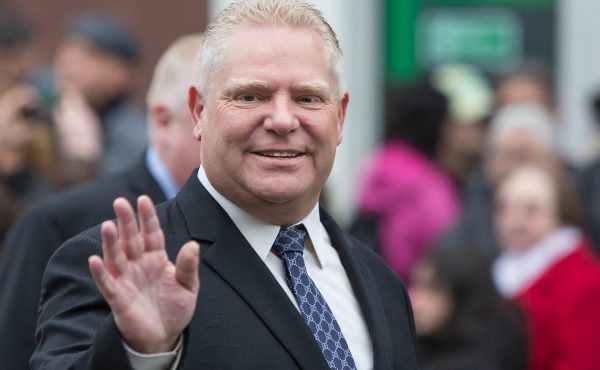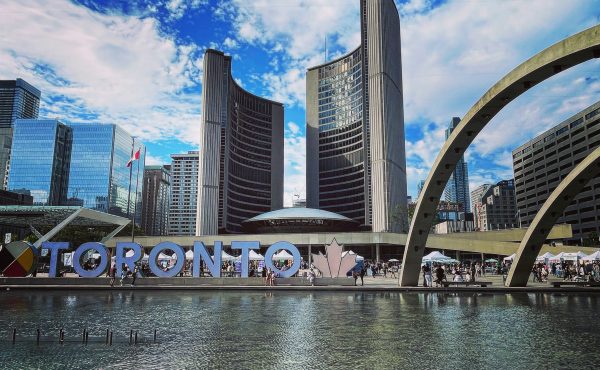
Every fiscal conservative in this city should thank TTC chair Karen Stintz for daring last week to speak truth to power about the Eglinton Crosstown fiasco.
Yes, fiscal conservatives. Not just Transit City lovers.
By asking whether Metrolinx will be using the appropriate vehicles in that 19-km tunnel, Stintz nailed the key technical question hanging over Mayor Rob Ford’s plan to bury the entire LRT at a premium of $2.1 billion. But by proposing ways to stretch those dollars (a Sheppard subway extension to Victoria Park and a BRT corridor on Finch), she has, in effect, posed a hard-headed question that no one, to my knowledge, has adequately answered:
Can Metrolinx prove to Ontario taxpayers that it will maximize its massive investment in Eglinton by proceeding with Ford’s faith-based burial scheme?
Nope.
In fact, the curious reality is that neither the province, nor the city, has a clue. While Metrolinx has conducted so-called “benefits case analyses” on several other of its undertakings, Spacing has learned that the agency didn’t apply this kind of rigour to the Crosstown, even though it officially ranks as Canada’s most expensive infrastructure project.
In other words, we haven’t seen any kind of thorough-going side-by-side analysis comparing the original Eglinton to the mayor’s version. No one’s tried to project development activity or estimate incremental tax assessment growth along the corridor where the line will be buried. No one’s attempted to calculate whether the additional capital outlay will generate a commensurate increase in revenue, or how the marginal operating expenditures of the two configurations will compare ten, twenty or thirty years hence.
No one’s sought to determine what happens to long-term operating costs if rider demand on the buried LRT exceeds capacity sooner than predicted. And no independent entity has tested the mayor’s allegations about chronic traffic congestion on post right-of-way St. Clair West, which he is the cudgel he uses to justify burying the Crosstown along its entire breadth.
All we know is that the all-buried version will move slightly faster than the semi-buried original. But even that differential is anything but assured because the service levels are determined not just by speed, but also by head times.
Real fiscal conservatives would demand crisp answers to these questions before proceeding, simply because they’d want solid assurances that scarce taxpayer dollars are being deployed efficiently and effectively.
Now consider this: if Greater Toronto accounts for half of Ontario’s economic activity, and the City of Toronto half of that again, as is conventionally estimated, then 416 taxpayers are putting up about $500 million of the funds required to bury the line completely – i.e., roughly $200 for every man, woman and child.
By the same logic, however, taxpayers in the rest of the province are anteing up 75% of that extra $2.1 billion in burial fees. If the brothers Ford were genuine, as opposed to phony, fiscal conservatives, they’d be especially attentive to the externally-generated portion of the Crosstown budget, because the bulk of that money – i.e., other people’s money – will not benefit those who foot the bill.
But of course, there’s absolutely no evidence of any such concern. They simply grabbed the cash on the barrelhead and made a run for the door (possibly in contravention of various municipal procedures, according to a legal opinion sought by Joe Mihevc).
Lacking any kind of independently confirmed justification for his scheme, Ford last week took to Facebook to mulishly defend his position in the face of mounting council and public opposition. (His post, as was widely noted on twitter, contained several glaring errors, as well as a strong dose of revisionism: By claiming that subways formed the backbone of Toronto’s transit planning between 1910 and 2007, he conveniently neglected to mention that the city abruptly stopped building rapid transit in the 1990s because of the downloading imposed by the Harris government, of which his late father, Doug, was a charter member.)
How this plays out politically remains to be seen, although it’s clear that the controversy, brewing for months, has landed like a bomb. Stintz and others on the right, including members of Ford’s cabinet, are looking for a compromise solution. But absent another kumbaya moment, it is not difficult to imagine that a resolution on Eglinton could yield a result similar to the budget compromise – a razor-thin margin of victory that turned on the absence of a stalwart supporter (Ron Moeser).
While I agree that council is supreme, there’s no way that a very tight vote on a decision as far-reaching as the Crosstown configuration could be considered a victory, regardless of which side prevailed. And a split council certainly could not be construed as evidence that the city has got its “act together,” as one of Dalton McGuinty’s cabinet ministers pithily put it last week.
Rather, a very close council vote on Eglinton should be seen as a bone fide governance crisis, especially if the mayor (I’m talking about the office, not the man) is on the losing side. By petulantly refusing to compromise or listen to reason, the mayor (the man, now, not the office) is also revealing that he’s failed to learn the central lesson of leadership: that politics, at its core, is about the art of the possible.
In the event, it falls to the province/Metrolinx to act like the grown-up (for a change). In fact, I’d argue that the McGuinty government has only one defensible option available to it in the event of a split decision: press the pause button and order up the benefits case analysis it should have commissioned in the first place.
Given the Liberals’ woefully undisciplined approach to Metrolinx, I’m not holding my breath. But true fiscal conservatives would demand nothing less.





15 comments
A correction re Council math: Even if Ron Moeser had not been ill, most of the budget motions would still have passed. Votes that were 23-21 would have been 23-22.
As for the benefits case, it is important that this be conducted on a level playing field. Metrolinx argues for the all subway option claiming it will attract many more riders due to higher speed. However, many of these are simply assigned by the demand model from trips that would otherwise take the Danforth subway, and it’s not clear that the $2b is actually buying us a big jump in transit usage or capacity where it is actually needed.
That’s one huge problem with the “benefits case analyses” — they look only at options for one line, not for the network — ie would money be better spent on a Finch West LRT than on burying Eglinton. Metrolinx has been cooking the books on these things for far too long.
Well said. If the most expensive infrastructure project cannot be examined properly then we deserve exactly what we end up. An expensive boondoggle and a lasting disaster too expensive for words.
As far as I can tell, nobody’s done a cost-benefit analysis for Stintz’s plan over Transit City either.
“… burying the Crosstown along its entire breadth.”
That’s an odd word to use there. I’d have used “length”.
However, that gave me a wonderful crackpot idea: Would there be any benefit to only burying one direction of the Crosstown for Transit City’s underground stretch (Jane/Keele to Brentcliffe)? Align it so that the rides away from Yonge are on the surface and the ones towards Yonge are directly beneath (or something; this is less than half-baked). Would there be enough room on the surface for one lane of LRT ROW? Would building a smaller tunnel cost less? Would it be structurally sound?
Quote:
“No one’s sought to determine what happens to long-term operating costs if rider demand on the buried LRT exceeds capacity sooner than predicted. And no independent entity has tested the mayor’s allegations about chronic traffic congestion on post right-of-way St. Clair West, which he is the cudgel he uses to justify burying the Crosstown along its entire breadth.”
A good reason for this is that this kind of analysis is expensive. Licenses for state-of-the-art travel demand forecasting software (such as EMME/3) run in the thousands of dollars, not to mention the expertise/experience required to use them.
Furthermore, network data is owned by the various governments, and therefore cannot be used without their consent. Given the justified prudence of these government employees, it is not difficult to see how even NGOs have a difficult time comparing different transit alternatives, let alone regular citizens.
Forgive the naive question, but wouldn’t an environmental assessment provide a more comprehensive analysis? Isn’t that what it’s designed for?
Why not build a full subway if he wants to bury the damned thing? Itll carry twice as many, move faster, etc etc….
Light rail goes ABOVE the road. that is its intended design.
At this point it wouldn’t cost that much more to just build a damn subway along eglington.
It will be a good thing if Transit City can be saved. It would bring more reliable mass transit to the many priority neighbourhoods of this megacity’s inner suburbs within the quickest time frame for the least amount of money. Historically in the inner city the streetcar system was built first in the late 19th-early 20th centuries followed by the subway construction of the mid 20th century. The Transit City LRVs could probably be run in long multiple unit consists, which along with the proper traffic signalling programming would bring fairly rapid surface rail transit service to many neighbourhoods suffering with overcrowded infrequent bus service. If there is anywhere though that truly needs to see an expansion of subway infrastructure would probably be in the inner core as pressure relief to the maxed out Yonge subway line. Unfortunately the Yonge subway was not given the extra tunnelling to serve future demand and now city residents are faced with this headache. If one lives in the inner core and can walk to wherever one needs to go then that has the most promise for now, anything else involving the use of our transportation infrastructure is just in for a headache. With the infrastructure becoming ever less reliable it is probably that factor which compels more people to live in a downtown condo or apartment and just walk. : (
If we do a full subway the portion from Kennedy to Scarbro Town would have to be completely reworked since full subways won’t fit in the SRT ROW.
Doing all or any of these studies takes time, unfortunately. Transit City already had all of these things done and that shouldn’t really have been messed with. Maybe it wasn’t perfect, but all of that preliminary work was done and shovels were ready to hit the ground.
Most of the biggest cities in the world are using or building LRT now. Cities that have higher populations today than TO projects to 50-100 from now. LRTs can work here, along with new subways where they are warranted and along with increased city-wide, all-day, long haul service from Go Transit’s rail corridors.
Stintz is right – if it will be built entirely underground, it should use the same technology as Toronto’s current subway system. If it uses LRT technology, it should maximize the benefits of that technology by going above ground where there is space. The important thing is that stations/stops must be far enough apart, so average speed is high enough to attract riders traveling over long distances.
One thing that we don’t need are more studies. We just need a decision from council to either build a full subway, or a cost effective LRT, that can be completed as quickly as possible.
Jeremy: Any decision that isn’t “continue Transit City” would legally require more studies, and I’d argue democratically require more public consultations.
In my mind, at least, Stintz is being the biggest grown-up. Against the will of the guy who appointed her, she’s said (in as politically dangerous terms as she dares, I suppose), “Hey, wait. This is a bad idea.”
It’s too bad her power really sort of ends there. Or does it? Can the TTC Commissioner do anything more?
John,
I agree with your analysis. But only to some degree.
Whether or not the Ford Brothers realize it, they are aligning themselves with a long tradition of conservative politicians in western countries of wasting precious transit dollars and opportunities as ostentatiously and as extravagantly as they can. They do not want transit to succeed.
If the Eglinton line is buried, it will still use the smaller light rail cars which carry fewer people. And it will only be able to stop every couple of kms thereby making it less convenient to use than an above-ground line. And it will cost more than every other option precluding the construction of every other project on the table. If you did not want transit to succeed, would you not have just bowled a strike?
Conspiracy theory. Maybe, but consider this. When Harris stopped construction of the proposed Eglinton West subway line, it was not sufficient for him to stop construction. He had to waste tens of millions of dollars in precious transit money by filling in the hole again. And when Mel got his Sheppard line to nowhere, he insisted on building through some of the most sparsely populated suburbs before stopping abruptly at a clump of densely developed housing. And he stopped building the line to York U, a campus with tens of thousands of students and no connection to downtown. The YU line got one extra station about a kilometre closer to the school.
How many millions went down the pan on these lines to nowhere? How much better does the system actually function with these additions?
It’s not Canadian, but the most egregious example of which I am aware is the “Northwest Metro” which was proposed for Sydney, Australia. A subway line, basically. (Virtually all of their current network is electrically driven overground trains.) When that project was cancelled, the state spent over $400 million paying out the construction companies for broken contracts. Everyone laughed except the taxpayers.
I’ll stop here. But I do not believe the agenda of the Fords or any other conservative (big “C”, little “c”, whatever) is to spend dedicated transit dollars as wisely and efficiently as possible. I believe their agenda is to waste them as publicly and as conspicuously as they can. And what they do build serves as few people as poorly as possible.
The statement they are making is clear and plain.
-Gerry H.
Is it true the Mayors decision to cancel Transit City could cost the taxpayers up to 65 Million? Is it true we could build the Eglinton LRT for 2 Billion less by putting some of it on the surface through Scarborough?
In tight fiscal times I do not think Mayor Ford is making best use of our hard earned tax dollars. I support TTC Chairperson Karen Stintz’s proposal to run the Scarborough part of the LRT at the surface and reinvest the remainder to improve transit for those not living near Eglinton Ave.
The full city council needs to discuss and vote on such a large scale infrastructure investment. If it needs a special meeting of council, so be it- democracy will prevail. Our elected officials need to speak up!
This whole project will be cancelled. Fiscal conservatives don’t really want subways etc. They love there cars far to much.All this bickering is a ploy by Ford to have the to can the whole thing. Clever. Why would anyone believe that Ford is interested in public transit. Think about it.
Signed
Someone who supports public transit projects